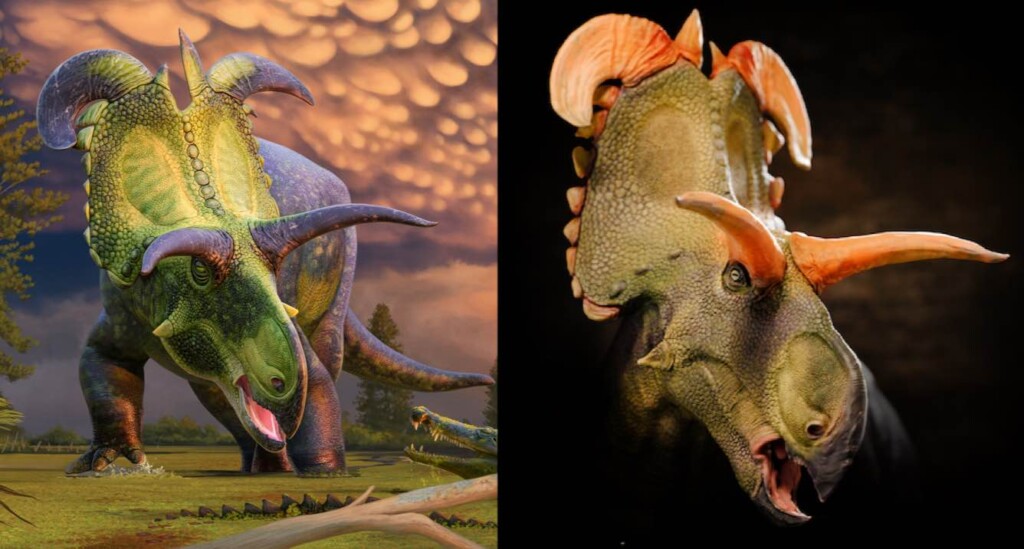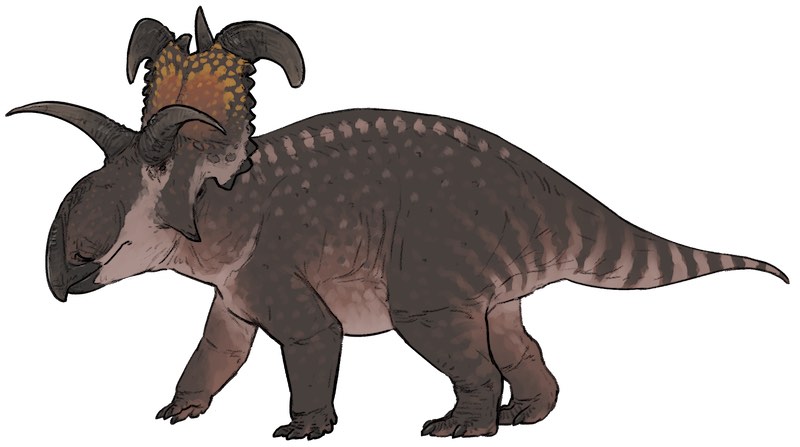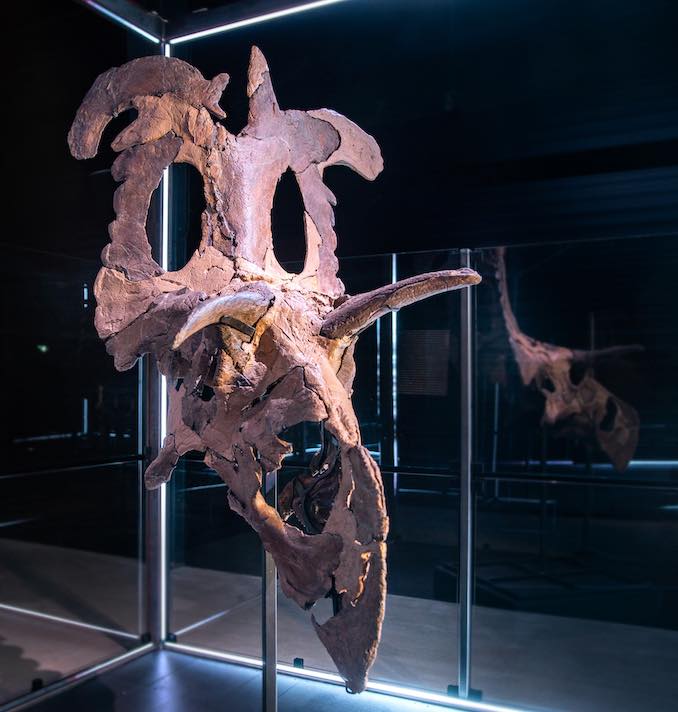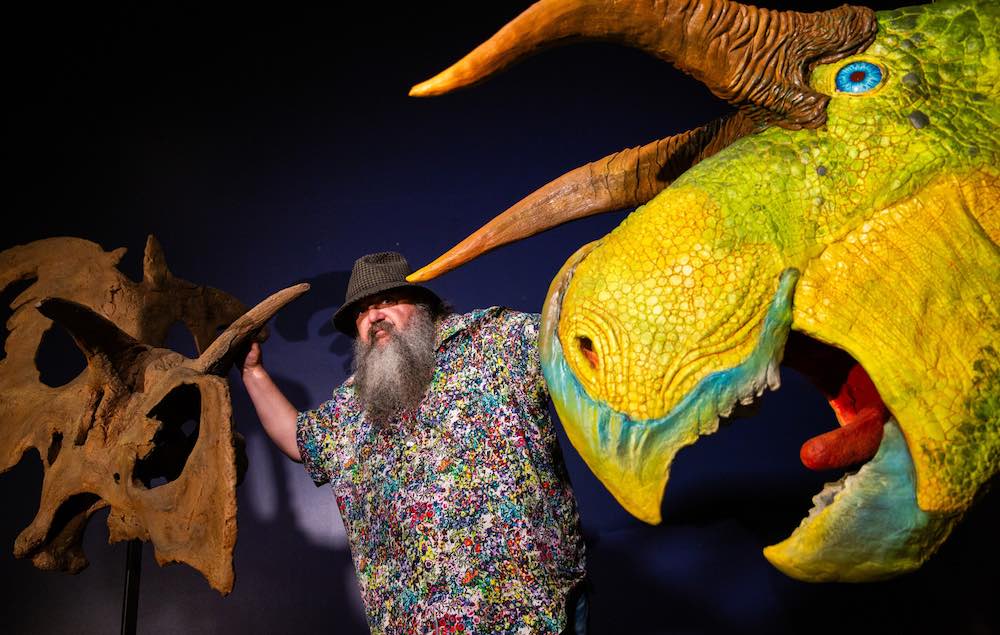 (Left) Reconstruction of Lokiceratops rangiformis dinosaur by Andrey Atuchin / Museum of Evolution, Denmark (right) Fabrizio Lavezzi © Evolutionsmuseet in Knuthenborg – SWNS
(Left) Reconstruction of Lokiceratops rangiformis dinosaur by Andrey Atuchin / Museum of Evolution, Denmark (right) Fabrizio Lavezzi © Evolutionsmuseet in Knuthenborg – SWNSA remarkable new species of giant horned dinosaur has been unveiled at the Natural History Museum of Utah, the fifth horned dinosaur ever discovered.
First discovered in the badlands of northern Montana in 2019, it's among the largest and most ornate ever found, with two huge blade-like horns on the back of its frill—a distinctive horn pattern that inspired its name, Lokiceratops (‘Loki’s horned face’), to honor the blade-wielding Norse god Loki.
Estimated to be 22 feet long (6.7 meters) and weighing around five tons (11,000 lbs), the Lokiceratops rangiformis appeared at least 12 million years earlier than its famous cousin Triceratops and was the largest horned dinosaur of its time.
“This new dinosaur pushes the envelope on bizarre ceratopsian headgear, sporting the largest frill horns ever seen in a ceratopsian,” said Joseph Sertich, a paleontologist with the Smithsonian Tropical Research Institute and Colorado State University, who announced the new species this week in a published study.
“We started to realize that it was different than anything that anyone's ever seen before,” said co-lead author Mark Loewen, a paleontologist at the Natural History Museum of Utah and geology professor at the University of Utah.
 Lokiceratops rangiformis reconstruction by Ddinodan – CC BY 4.0
Lokiceratops rangiformis reconstruction by Ddinodan – CC BY 4.0“These skull ornaments are one of the keys to unlocking horned dinosaur diversity and demonstrate that evolutionary selection for showy displays contributed to the dizzying richness of Cretaceous ecosystems,” added Sertich.
The second name, rangiformis, which means ‘looks like a caribou’, refers to the differing horn lengths on each side of the frill, similar to the asymmetric antlers of caribou and reindeer.
Like other ceratopsian (horned) dinosaurs, Lokiceratops had a mouth filled with more than 200 teeth honed into a shearing, cutting surface that could chop vegetation and small branches.
While ceratopsian ancestors were widespread across the northern hemisphere throughout the Cretaceous period, their isolation on Laramidia—the island continent that stood alone where Montana now sits, a few miles from the Canada—led to the evolution of huge body sizes and distinctive patterns of horns above their eyes and noses, on their cheeks, and along the edges of their elongated head frills.
ANOTHER NEW GIANT: Newly Discovered Giant Dinosaur Species May Be Closest Known Relative of T. rex
 Lokiceratops_rangiformis skull fossil bones – Museum of Evolution in Denmark
Lokiceratops_rangiformis skull fossil bones – Museum of Evolution in DenmarkMore than 78 million years ago, Lokiceratops inhabited the swamps and floodplains along the eastern shore of Laramidia, the island that was created when a great seaway divided the continent around 100 million years ago. (Mountain building and dramatic changes in climate and sea level have since altered the hothouse world of Laramidia where Lokiceratops thrived.)
Fossils recovered from this region suggest horned dinosaurs were evolving in a small geographic area—found nowhere else—implying the dinosaur diversity here is underestimated.
“Previously, paleontologists thought a maximum of two species of horned dinosaurs could coexist at the same place and time,” said Professor Loewen. “Incredibly, we have identified five living together at the same time.”
The skull of Lokiceratops rangiformis is dramatically different from the other four animals it lived alongside.
It possesses several unique features, among them are the absence of a nose horn, huge, curving blade-like horns on the back of the frill—the largest ever found on a horned dinosaur—and a distinct, asymmetric spike in the middle of the frill.
 Paleontologist Mark Loewen stands next to casts of the head and skull of Lokiceratops rangiformis – Photo by Mark Johnston / Natural History Museum of Utah
Paleontologist Mark Loewen stands next to casts of the head and skull of Lokiceratops rangiformis – Photo by Mark Johnston / Natural History Museum of UtahOverall, the horned ceratopsids evolved around 92 million years ago (during the Late Cretaceous), and diversified into a myriad of fantastically ornamented species that survived until the end of the time of dinosaurs.
AMAZING: New Dinosaur With Rows of Bristles On its Head Like a Toothbrush Has Been Discovered
Scientists have argued about the patterns of evolution within the group of horned dinosaurs for years.
“Rapid evolution may have led to the 100- to 200-thousand-year turnover of individual species of these horned dinosaurs,” said Loewen.
This rapid evolution is most consistent with sexual selection acting upon these animals. “Sexual selection acting on the genes responsible for the horns of the frill would produce modifications to cis-regulatory elements that would express differences in the size and shape of individual frill horns producing the variations in patterns we see in these animals,” said coauthor Jingmai O’Connor of the Field Museum in Chicago.
MORE DINO NEWS: One Man Stumbled Upon Complete Stegosaurus Skeleton–Now Set to Earn Millions at Auction
SHOCK ALL THE LOKI FANS By Sharing The Magnificence on Social Media…
Source link

